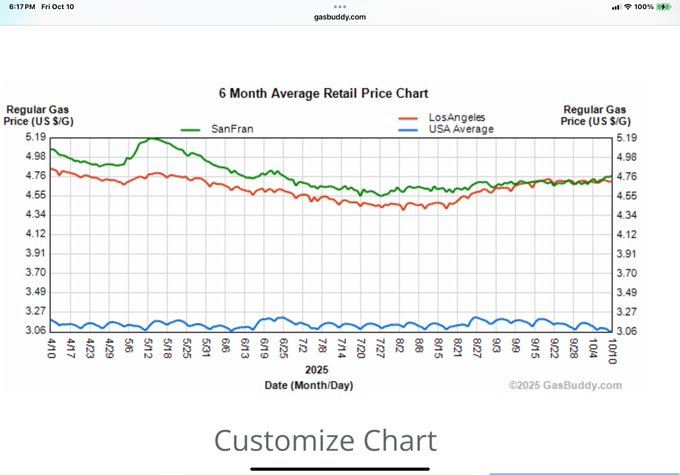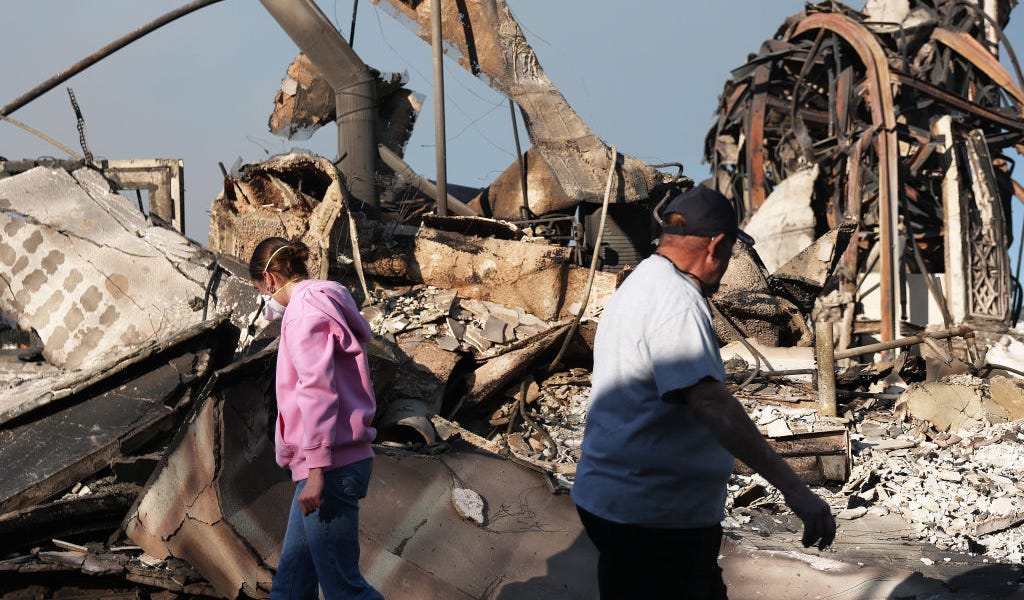We'll have our bullet train real soon! OK... maybe not.
Even the oil companies are moving out. Tech has taken a huge step out. Entertainment... out. We are a shell of what we used to be, and it's only getting worse. I keep wondering how far it has to go before the idiots in my state quit voting Democrat.
It's crazy how California just acts like it's own country... run by morons and fucking the people that live there. Just fucking incompetence run amok among local governments. California forces gas companies to make special gas for cars... so residents have to pay $1.50-$2.00 more per gallon of gas. For what? And the Palisades fire wiped out 20+ years of any "special" benefits that gas may have had... due to Government negligence and incompetence. And fucking Californians in the ass...
And speaking of the Palisades fire and shitty Government
lol... Califonia Officials are claiming that 80 days for permit approval is great... compare to the usual 24 months. Holy Fuck... 24 months is normal? Most people have their homes approved and built in under a year. 24 months just for permit approval? And for Malibu... 6 years for permit approval?
The LA Fires Destroyed 11,000 Homes. Less Than 10% Have Permits to Rebuild
Of the thousands of residents needing to rebuild after this year’s California wildfires, Andy Weyman would seem especially well positioned. The TV and stage director had remodeled his Malibu home just five years earlier and had city-approved blueprints in hand, with the same architect set to...
www.carriermanagement.com
Yet eight months after the Palisades Fire destroyed almost 600 Malibu houses, the city has issued only two rebuilding permits. Weyman needed geological tests to ensure the stability of his bluff-top lot. Construction costs are roughly double his insurance coverage.
Rebuilding after California fires has long been an arduous process — in Malibu, only about 40% of the 488 homes that burned in the 2018 Woolsey Fire have completed reconstruction. But government agencies vowed to cut red tape after the devastating toll of the January blazes, located in residential areas that were home to tight-knit communities and highly desirable real estate
Some residents say the process is still being dragged out. Rich Wilken, 78, put off retirement as an architect after losing his Pacific Palisades home of 47 years, and agreed to design 10 new houses in the burn area for himself and friends. But he says the effort has been dogged by a changing cast of inspectors at LA’s building department who offer conflicting opinions on his plans, requiring resubmissions that take time and money.
“The building department’s answers change every day,” Wilken said.
Bass repeatedly speaks about how rebuilding is happening faster than any wildfire in California history, noting that at least 220 houses in the Palisades are already under construction. Plan approval times in the district average 69 days, compared with as much as 24 months outside the fire zone, according to city officials.
In the area of Eaton Fire, the pace of permit approvals is much quicker than before the disaster — an average of 72 days, compared with about eight months previously.
Annie Compton is among those who decided to walk away. The 41-year-old film and TV writer had initially planned to return to the Altadena neighborhood she fled with her husband and two children, having long loved the community’s diversity and reputation as a haven for artists. But navigating the bureaucracy, paperwork and insurance grew to be too difficult, and the math just wouldn’t pencil out.
She said many of her former neighbors also don’t plan on rebuilding for the same reasons: It’s too expensive and too difficult.
In Malibu, it took an average 126 days for approval of the first two rebuilding permits, but that compares with a typical six years outside the burn areas in the beachfront town, according to Yolanda Bundy, Malibu’s community development director who’s overseeing the reconstruction.
Remember this? Promoted as donation money going directly to victims?
In typical California political fashion... it's all been swallowed by NGO's and no one knows hows it's been spent. None of the NGO's are accountable for how the money is spent.
Where Did $100 Million in LA Fire Relief Money Go?
Some Southern California residents say there are few signs of the ‘direct relief’ promised by FireAid.

www.thefp.com
Quentin Fleming was
one of the thousands of people who lost their homes in the wildfires that ravaged Southern California in January. He received $750 from the Federal Emergency Management Agency (FEMA), a few thousand dollars from the Red Cross, and assistance in finding a rental home from an insurance company. He has lived there ever since then.
But there have been few signs of help, either for Fleming or his neighbors in the Pacific Palisades neighborhood of Los Angeles, from the highly publicized “FireAid” benefit concert, which raised $100 million for what organizers said would be “
direct relief” to victims and communities.
“We haven’t really seen any Palisades organizations benefit from the FireAid funds,” said Fleming, 67, a University of Southern California business professor who lived in Pacific Palisades for nearly 25 years. He told me that the area “is often misperceived as this very exclusive, affluent enclave, but that’s not always the case.” People who lived in rent-controlled apartments, inherited homes that would have been unaffordable to buy, or were underinsured when the wildfires hit especially need financial help, he added.
Sue Pascoe, a Pacific Palisades resident of 30 years who lost her home in the fire, runs a local news blog called
Circling the News. She received an email from a reader asking about how to apply for funds raised through FireAid.
She found out that the money was being distributed to various nonprofit groups instead of directly to fire victims.
“There’s all sorts of skullduggery going on, and basically wildfire victims and Palisades and Altadena got no direct relief,” said Pascoe.
FireAid distributed $50 million of the $100 million to more than 120 nonprofits and community groups in a first round of disbursements. FireAid also chose 68 recipients for $25 million in a second round. Applications for the last $25 million are being accepted through a
Google Form on FireAid’s website.
Specific grant amounts aren’t disclosed on the website. But recipients include
Inclusive Action for the City, a nonprofit community development financial institution that
gave out $500 in cash to outdoor workers like street vendors, landscapers, and recyclers. The
Pilipino Workers Center received an undisclosed sum for “supporting workers displaced by the fires,” and money went to the
California Native Vote Project to help displaced Native American families with financial assistance and mental health services.
$100M in LA wildfire aid is being doled out to fund pet clinics, DEI projects and fungus planting— but not a dime directly to victims
The $100 million FireAid benefit concert has responded to backlash with a new audit report, yet fire victims are still scratching their heads.

nypost.com
An audit commissioned by FireAid and released Monday showed how the money so far has been spent — and the causes that are being funded are all over the map.
The beneficiaries ranged from the Buddhist Tzu Chi Foundation ($100,000) to a group making podcasts about the wildfires ($100,000), to the local YMCA ($250,000).
Several grants went to nonprofits that focus on political advocacy for minority groups, including the NAACP Pasadena ($100,000), the Los Angeles Black Worker Center ($250,000), My Tribe Rise ($200,000), and the CA Native Vote Project ($100,000), which conducts voter registration drives for Native Americans across the state.
“There are a lot of people in our group chats who are like, ‘What’s the FireAid money being used for?’ Because I don’t think any of us have seen any of it,” said Ben Einbinder, who has become a community organizer since losing his home in the Palisades.
But even though FireAid has revealed which organizations it has given money to, it hasn’t revealed what exactly the organizations are doing with the cash.
“Some of the organizations … it would be hard to say whether they were actually using the FireAid money for wildfire relief,” Einbinder said.
See Also

The situation amounts to false advertising at best, Howard said.
“Even the artists performing on stage were telling fans and people engaging with the concert that this money is going directly to the victims,’’ the struggling resident said.
“But the trickle-down on that makes it so the people who need it the most haven’t seen anything.’’
Howard said the issue for him and many of his neighbors is not about any individual FireAid beneficiary organization, adding that many probably do good work.
Instead, he said, there are simply too many of the charities receiving the money to put it to any coordinated, meaningful use to help fire victims.
Of course, that’s assuming all of the organizations are directly helping fire victims, which nobody has been able to verify.
“FireAid is giving money to a nonprofit that teaches other organizations how to be a nonprofit,” Howard noted, referring to the Center for Nonprofit Management, which got $250,000.


![dunn [<dunn] [<dunn]](http://i.imgur.com/tNvC16j.png)






